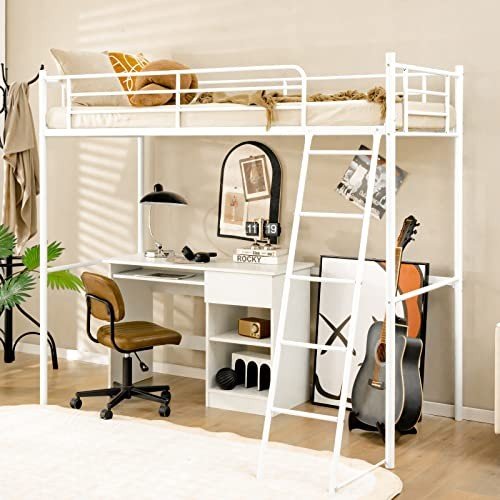Why No One Cares About Bunk Beds

Exploring Bunk Beds: A Comprehensive Guide
Bunk beds have long been a staple in kids's bed rooms, dorms, and even homes with limited space. Not just do they offer a practical sleeping option, but they also develop an enjoyable and imaginative environment for kids and a great space-saver for adults and families. This short article will check out whatever you need to understand about bunk beds, from types and materials to security tips and purchasing advice.
Table of Contents
- Types of Bunk Beds
- Standard Bunk Beds
- Loft Beds
- Triple Bunk Beds
- L-Shaped Bunk Beds
- Material Options
- Wood
- Metal
- Security Considerations
- Purchasing Guide
- Frequently asked questions
Kinds Of Bunk Beds
Bunk beds come in numerous styles to suit different needs and choices. Here's a breakdown of the most typical types:
Conventional Bunk Beds
Standard bunks normally include 2 beds stacked vertically on top of one another. These beds are perfect for siblings sharing a room or for optimizing sleeping space in visitor rooms.
Loft Beds
Loft beds stand likewise to conventional bunk beds however do not have a lower sleeping location. Instead, they typically include a desk or seating area below, making them a great choice for small rooms needing multifunctionality.
Triple Bunk Beds
Triple bunk beds are created for three residents, with beds stacked in a three-tier setup. These are less typical but can be an enjoyable service for big households or sleepovers.
L-Shaped Bunk Beds
With one bed placed horizontally and the other vertically, L-shaped bunk beds are frequently equipped with additional features such as desks or storage drawers and can complement corner spaces in a room.
Contrast of Bunk Bed Types
| Bed Type | Suitable Use | Description |
|---|---|---|
| Conventional | Shared bed rooms or guest spaces | 2 beds stacked vertically |
| Loft | Small spaces needing multi-purpose space | Upper bed with open space beneath |
| Triple | Big households or pajama parties | Three beds stacked vertically |
| L-Shaped | Corner or versatile areas | A mix of vertical and horizontal beds |
Product Options
Bunk beds are made from different products, with wood and metal being the most common. Each material has its pros and cons.
Wood
- Toughness: Generally robust and can endure years of use.
- Aesthetic Appeal: Offers a traditional appearance that can blend with various decorations.
- Weight Capacity: Typically stronger; can support much heavier weights.
- Drawbacks: May be more costly than metal options and can be prone to scratches.
Metal
- Durability: Generally light-weight and easy to move but still sturdy.
- Modern Design: Often can be found in streamlined designs, making it appealing for modern areas.
- Cost-Effective: Usually cheaper than wooden choices.
- Disadvantages: Can be cold to the touch in winters and might not have the very same aesthetic appeal for some purchasers.
Safety Considerations
When it pertains to bunk beds, security can not be overlooked. Here are essential security ideas to bear in mind:
- Guardrails: Ensure that the leading bunk has guardrails on both sides to avoid falls.
- Sturdy Construction: Check for a strong build and sturdy products to withstand weight and motion.
- Weight Limit: Adhere to the maker's weight limitation for both the upper and lower bunks.
- Ladder Design: Choose bunks with a safe, easy-to-climb ladder and prevent any sharp edges or rungs.
- Age Restrictions: Most manufacturers suggest that children under the age of six must not oversleep the upper bunk.
Buying Guide
When searching for bunk beds, think about the list below factors to discover the best suitable for your needs:
- Space Availability: Measure the space size and ceiling height, ensuring there is appropriate space for the top bunk.
- Bed Size: Decide between twin, full, or larger sizes based on your requirements and the size of the room.
- Style Preference: Consider the overall design of the bed room to find a suitable style.
- Ease of Setup: Look for a bunk bed that is straightforward to put together.
- Spending plan: Bunk beds come in different rate ranges, so determine a spending plan before starting your search.
Frequently asked questions
1. What is the recommended age for kids to sleep on the leading bunk?
Kids aged 6 and older are typically advised to sleep on the leading bunk to minimize the threat of falls.
2. How can Bunk Beds For Adults UK natashabloodworth.top make my bunk bed much safer?
To enhance security, ensure guardrails are effectively set up and check that the bed is put on a flat surface area. Furthermore, encourage kids to utilize the ladder thoroughly.
3. Can I convert a bunk bed into two separate beds?
Lots of bunk beds are designed to be convertible. Check the maker's specifications for convertibility functions.
4. What devices are available for bunk beds?
Typical accessories include bed linens, storage drawers, staircases rather of ladders, and tented canopies for a fun visual appeal.
5. How do I keep my bunk bed?
Regular checks for loose screws or structural integrity can help ensure security. Dust the bed frequently and clean spills without delay to keep the materials in good condition.
Bunk beds are versatile and a space-efficient option for different living circumstances, from children's spaces to visitor lodgings. With numerous designs and materials readily available, prospective purchasers have a wealth of options to consider, ensuring a mix of functionality and looks. By focusing on safety and following the pointers outlined in this guide, people can find the best bunk bed that fits their space and lifestyle, all while creating a pleasurable sleeping environment.

